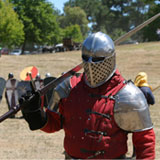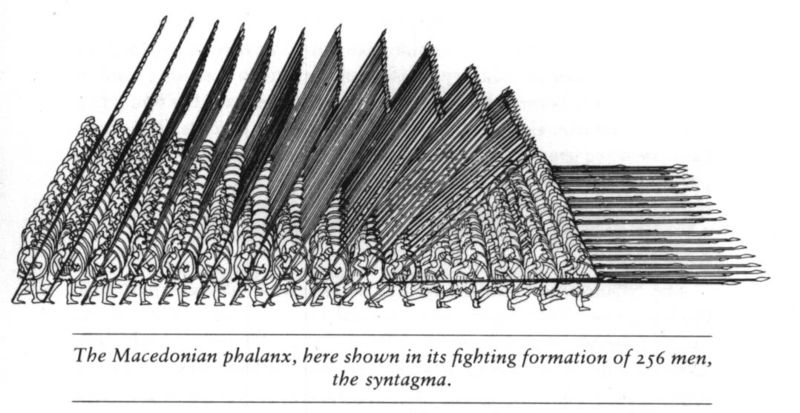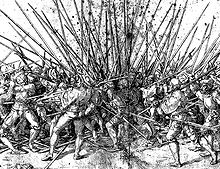 |
|
|
|
| Author |
Message |
conal
Site Admin
|
|
|
 |
conal
Site Admin
|
 Posted: Sat Sep 05, 2009 1:47 am Posted: Sat Sep 05, 2009 1:47 am |
 |
|
| Its a seige, it counts.
|
|
|
 |
adrianf

Location: palmerston north
|
 Posted: Sun Sep 06, 2009 8:04 pm Posted: Sun Sep 06, 2009 8:04 pm |
 |
|
got to love the english lords comment
Sir Garnet Wolseley, taking over as Commander-in-Chief from Lord Chelmsford, was unimpressed with the awards made to the defenders of Rorke’s Drift, saying “it is monstrous making heroes of those who shut up in buildings at Rorke’s Drift, could not bolt, and fought like rats for their lives which they could not otherwise save.”
_________________
surrender to temptation, you never know when it will come your way again |
|
|
 |
conal
Site Admin
|
 Posted: Mon Sep 07, 2009 6:01 pm Posted: Mon Sep 07, 2009 6:01 pm |
 |
|
| A dreadful melee amongst the Mealie bags all the same, what?
|
|
|
 |
Boyd

Location: London
|
 Posted: Mon Nov 09, 2009 7:06 pm Posted: Mon Nov 09, 2009 7:06 pm |
 |
|
I got "Zulu Dawn" at the Wharehouse for cheap last week. Was a beautifully filmed movie. How the Victorian's managed to take over so much of the world with some of the dumbasses they had in charge is amazing to say the least!
_________________
Experience is not what happens to a man; it is what a man does with what happens to him.
Aldous Huxley in "Texts and Pretexts", 1932 |
|
|
 |
Gaius Drustanus
This account is inactive
Location: auckland
|
 Posted: Mon Nov 09, 2009 9:45 pm Posted: Mon Nov 09, 2009 9:45 pm |
 |
|
The same applies to the Romans. The German Nation is still grateful that the Fates dealt them Varus. A fact recently commemorated with Gusto September 2009 in Minnesota by their Migrant community in the U.S.A. (two thousand years from September 9 AD).
"Varus, Varus, give back my Legions!"
I think, often, Economics has a lot to do with it.
_________________
Disclaimer:Opinions expressed by Warlord Drustan, this debauched demented megalomaniac are solely his own & do not reflect those of LegioIIAugusta or the Roman people in any way. |
|
|
 |
crite40
Location: Helensville Rodney
|
 Posted: Mon Nov 09, 2009 10:22 pm Posted: Mon Nov 09, 2009 10:22 pm |
 |
|
Yes. But in the end it's usually a question of technology especially in modern times. From what I've read Rourke's drift held out because they had a lot of supplies, including many spare Martini Henry .45 rifles. It seems that when they got hot after a few rounds they tended to jam (soft rolled brass cartridges). The blokes at the drift had several rifles each and could always get
a quick exchange and plenty of ammo. A scary spot though with less than 100 against 5,000 or so. Of course all the VC's were given to help cover up the previous ignominious defeat at Idiswanaha(sp can't look it up at the moment!).
According to "A social history of the machine gun" the British always put down the new automatic weapons. They preferred to think that the individual British soldier was their secret weapon against "savages".
BTW has anyone considered the effect of "barbarians" using the longbow against the Roman slavers legions. How effective would a loricated curiass have
been? Especially as it didn't cover that much of the body.
|
|
|
 |
Victorius
Location: IMPERIVM ROMANA: The Roman club with a Living History focus.New Roman Club
|
 Posted: Mon Dec 14, 2009 11:00 pm Posted: Mon Dec 14, 2009 11:00 pm |
 |
|
| crite40 wrote: |
...BTW has anyone considered the effect of "barbarians" using the longbow against the Roman slavers legions. How effective would a loricated curiass have
been? Especially as it didn't cover that much of the body. |
Roman armour covered all over. Many legionaries wore solid iron greaves, leather or laminated linen pteryges on their thighs (or knee-length maille), and banded armour down their right arms. If they didn't always have that, they had their long shields, which offered much protection, especially in closed ranks. Remember, most arrows fall from above, not from direct line-of-fire: that only leaves an effective range of 1-200 metres, and therefore places the archers too close to danger.
Tactics have been tried successfully with a full mobile archer force. Crassus (in 53 BC) led legions into the desert and got wiped out by Parthians employing their classic charge, turn right and run along the back or side of the line while releasing many arrows, then turning and taking off, also while releasing many arrows. The Parthian shot gives us the English phrase "passing shot" (if the linguists are to be believed).
When the Emperor Julian attempted to take on the Parthians' successors the Persians, his forces suffered a similar fate. One emperor (Valentinian) was even captured by forces using these tactics.
But they weren't always successful: Marcus Antonius (that's Mark Antony to you later period plebeians) managed to hold off the Parthians by marching his legions in a solid square, so their shields were outwards against the arrows at all times. They wore maille in his period too (it was before segmentata was widely utilised).
Simple fact is, archers against heavy infantry are only any good so long as they can ride away really fast. Archers on foot do not do so well, as the multitudes of Persians who died against Classical Greek hoplites in the fifth and fourth centuries BC can tell. Likewise the later Achaemenids against Alexander the Great: 200 000 archers deployed against a line of heavy Macedonian infantry could not withstand them, particularly after their flanks were rounded up like a scroll by the Companion cavalry of Alexander (it wasn't just Darius running away that did it, although that certainly helped!).
We can go to later periods to see how well archers did against determined infantry. They just didn't like being in direct firelines, as armoured troops could cross the 200 m distance too quickly, and cut them to pieces. Archers worked best from a distance, where they could rain arrows down from above. Crecy, Poitiers and Agincourt were exceptions: heavy armour generally beat archers. Case in point Bannockburn: Robert the Bruce's schiltrons may have stood their ground against unsupported English cavalry charging uphill, but earlier on in the same battle they nearly came a cropper against a thoughtful English archer contingent than shot directly into them, and would have continued if the Scottish cavalry had not come round and cut the archers to pieces (an outcome that often prevented archers from ever getting that close). The schiltrons did not have shields (being busy holding their big pikes with both hands), so they were vulnerable to archers (Edward I had used archers against them with considerable success some years earlier- a lesson his son Edward II was not quick to grasp). However, the heavy infantry and heavy cavalry were usually always able to take archers down, unless they were dug in to fortified positions (as the English were at Agincourt: and even then, those would have failed if the French knights had not elbowed the French contingent of crossbowmen, sent especially to kill the English archers, out of the way so they could stupidly have a go first).
So, back to the Romans then? Could longbowmen have stood against them? Simple answer, unless they were part of an all-arms force (dug-in positions, heavy infantry and heavy cavalry support, plus assorted peltasts and other light skirmishers) - not long at all.
_________________
VICTORIVS, BA.MA.HONS.I, IMPERIVM. ROMANA |
|
|
 |
Oskar der Drachen

Location: Masterton
|
 Posted: Tue Dec 15, 2009 7:29 am Posted: Tue Dec 15, 2009 7:29 am |
 |
|
I can't add anything to the argument, but thank you for this! One of the main reasons I'm on this list is to get nuggets of history like this from people who know what they are talking about.
Thanks again!
Oskar
|
|
|
 |
BigMac

|
 Posted: Tue Dec 15, 2009 8:45 pm Posted: Tue Dec 15, 2009 8:45 pm |
 |
|
| Victorius wrote: |
Tactics have been tried successfully with a full mobile archer force. Crassus (in 53 BC) led legions into the desert and got wiped out by Parthians employing their classic charge, turn right and run along the back or side of the line while releasing many arrows, then turning and taking off, also while releasing many arrows. The Parthian shot gives us the English phrase "passing shot" (if the linguists are to be believed). |
Shouldn't that be "parting shot"?
TTFN
_________________
There is a fine line between Hobby and Insanity |
|
|
 |
Victorius
Location: IMPERIVM ROMANA: The Roman club with a Living History focus.New Roman Club
|
 Posted: Tue Dec 15, 2009 9:31 pm Posted: Tue Dec 15, 2009 9:31 pm |
 |
|
| BigMac wrote: | | Victorius wrote: |
Tactics have been tried successfully with a full mobile archer force. Crassus (in 53 BC) led legions into the desert and got wiped out by Parthians employing their classic charge, turn right and run along the back or side of the line while releasing many arrows, then turning and taking off, also while releasing many arrows. The Parthian shot gives us the English phrase "passing shot" (if the linguists are to be believed). |
Shouldn't that be "parting shot"?
TTFN |
Thaks, yes: that's correct (when I wrote it, it did not quite seem right). As they were de-"parting", they'd make those shots.
Further information: the finds from the Battle of Visby (1361) did not show many dead from direct arrow-shots to the torso, but plenty of people wearing no head protection, or only maille coifs, died because arrows landed on their heads. The arrows were fell from above, having been shot from a great distance. This was one factor that led to steel helmets, particularly those with brims, as these keep arrows off the face, and hopefully the shoulder. It's also one of the reasons why Roman helmets had the broad rim running round the back (although that also helped to stop objects land on them when they were scaling walls).
One of the reasons why the Scottish-style schiltrons were not adopted all over Europe was their relative tendency to attract lots of arrows. They were too bulky to move out of the way at any great speed. Pike formations, on the other hand, were made up of many small units that moved rapidly all over the battlefield, one reason for this being that they could not be picked off by arrows.
_________________
VICTORIVS, BA.MA.HONS.I, IMPERIVM. ROMANA |
|
|
 |
Freebooter
Principal Sponsor

Location: Hamilton
|
 Posted: Wed Dec 16, 2009 9:05 am Posted: Wed Dec 16, 2009 9:05 am |
 |
|
| Quote: | | One of the reasons why the Scottish-style schiltrons were not adopted all over Europe was their relative tendency to attract lots of arrows. |
Halidon Hill. (from wikipedia)
"No sooner had the Scots entered the marsh at the foot of the hill than the first arrows began to descend. They continued to fall in great clouds as the schiltrons freed themselves from the marshy ground and began the ascent up Halidon Hill.
Having lost all momentum they moved slowly upwards, so tightly packed that even the most indifferent archer could scarcely fail to hit his target. The fire was so intense that many turned their faces away as if walking into a storm of sleet.
The Lanercost Chronicle reports; ...the Scots who marched in the front were so wounded in the face and blinded by the multitude of English arrows that they could not help themselves, and soon began to turn their faces away from the blows of the arrows and fall. Casualties were heavy, with some of the finest troops falling dead or wounded on the lower reaches of the hill. The survivors crawled upwards, through the arrows and on to the waiting spears."
|
|
|
 |
Victorius
Location: IMPERIVM ROMANA: The Roman club with a Living History focus.New Roman Club
|
 Posted: Wed Dec 16, 2009 3:22 pm Posted: Wed Dec 16, 2009 3:22 pm |
 |
|
By contrast, see the deployment of pikemen below. The first shows a Macdonian phalanx unit, with their long sarissas held upwards to ward off falling arrows. They would not have held them quite as upright as this, but more like the pikemen from the second picture. In both cases, these units would not have been subject to the withering punishment Nic describes above. The Macedonians deployed screens of light-armed peltasts, slingers and javelineers ahead of them to drive away archers using direct line-of-fire (if we may call it that); and the Late Medieval/Renaissance pike units ensured they moved really fast all over a battlefield to avoid arrows shot directly into them (the upwardly-held pikes prevented arrows falling from above, as they would get caught or slowed in the entangled shafts).
| Description: |
|
| Filesize: |
65.16 KB |
| Viewed: |
23307 Time(s) |

|
_________________
VICTORIVS, BA.MA.HONS.I, IMPERIVM. ROMANA |
|
|
 |
Victorius
Location: IMPERIVM ROMANA: The Roman club with a Living History focus.New Roman Club
|
 Posted: Wed Dec 16, 2009 3:22 pm Posted: Wed Dec 16, 2009 3:22 pm |
 |
|
Pikemen
| Description: |
|
| Filesize: |
20.62 KB |
| Viewed: |
23305 Time(s) |

|
_________________
VICTORIVS, BA.MA.HONS.I, IMPERIVM. ROMANA |
|
|
 |
conal
Site Admin
|
|
|
 |
|
|
 Please read the terms of use
Please read the terms of use
 Contact the Site Admin
Contact the Site Admin



